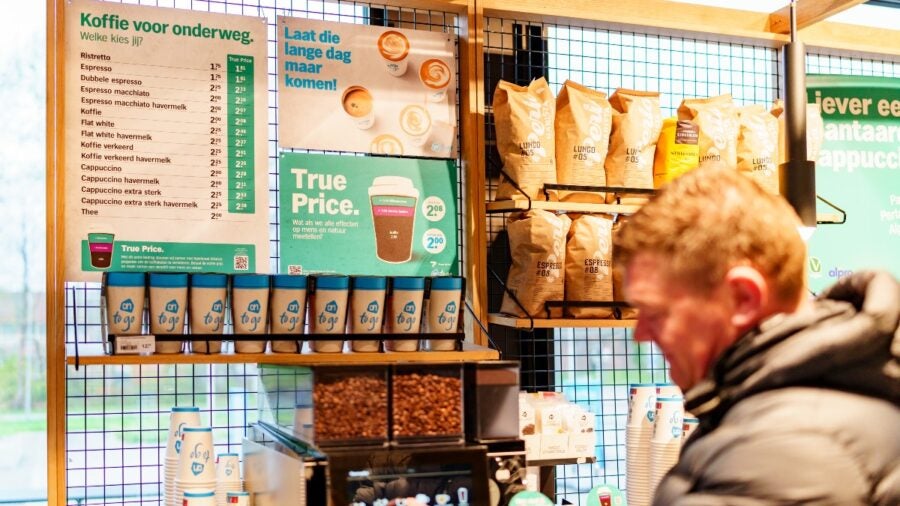
If you order a cup of coffee at selected Albert Heijn supermarkets in the Netherlands, you’ll be given a choice of two prices. You can either pay €2, the normal price, or €2.08 for the coffee’s “true price”.
The latter includes the social and environmental costs of producing the drink, including the CO2 emitted, the labour conditions of those working in the supply chain, and the water and other raw materials used. When a customer pays the true price, the retailer donates the difference to the Rainforest Alliance.
It’s a move backed up with in-store posters and QR codes, giving detailed explanations of the concepts behind the pricing to help customers delve deeper into the issues raised. courtesy of social enterprise True Price.
Whose idea was ethical pricing?
Of course, this isn’t the first attempt at a more ethical pricing structure. It’s an idea – putting the responsibility for sustainable decision-making squarely on the customer’s shoulders, while educating them about the consequences of their purchases – that the FairTrade Foundation pioneered in the 1990s.
Michel Scholte, who co-founded True Price in 2012, was inspired to set up the non-profit after working with poorly paid farming communities in Ghana and being shocked by the huge sums the cacao beans they produced would fetch in Amsterdam. His co-founder Adrian de Groot Ruiz worked on renewable energy solutions, but these never made it to market because the fossil-fuel alternatives were always cheaper, mainly because their environmental impact was never priced in.
“We externalise costs to people and to nature,” says Scholte. “That is something at the root of the global economy which is deeply unfair.”
They set about calculating the true prices of dozens of products around the world, and in 2018 created a true pricing scheme based on their findings. “People thought that we were crazy,” says Scholte. “Why would people pay more for things? The lawyers thought it was against competition, and the entrepreneurs thought it was communism.”
What does ethical pricing look like in practice?
But a growing number of companies did believe in the idea, including the chocolate brand Tony’s Chocolonely, which worked with True Price to bring down the true costs of its chocolate bars (in 2018 they were 55% below the industry average) and to pay a higher price to cocoa farmers. When, in 2020, Tony’s Chocolonely announced to customers that its bars would be more expensive in order to pay farmers a better wage, the news was announced in a proud and celebratory way, says Scholte.
I’d say to brands: ‘You’d better be ready to look good when we all get naked’
True Price has since worked with clothing companies, catering organisations, bakeries and banks, and in 2020 teamed up with the organic supermarket De Aanzet in Amsterdam to sell 1,000 products with both their true and normal prices listed. The supermarket has since seen a sales boost of 5%. Working with Albert Heijn, which has a 37% market share in the Netherlands, is its highest-profile collaboration to date.
Scholte says there are several ways to bring the concept of environmental and social cost transparency to consumers: giving customers a choice of the two prices, as seen in the Dutch supermarkets; default conventional prices and optional true prices; true prices as the default and conventional as optional; or the true price as the standard price.
He adds that True Price’s research shows that if you make the true price the default, 95% of people will pay it. But there is a trade-off here, as you risk excluding people who can’t afford it. That needs to be considered, says Scholte, especially with rising living costs across Europe, but he also notes that more than 3 billion people worldwide face inaccessibility to food. “Seventy per cent of the workers in the world work in food and they also need to get a living wage and income,” he says. “That is the bill we put on the table when we show the true price.”
How would retailers implement true pricing?
Mike Barry was the long-time director of sustainable business at Marks & Spencer and is now a sustainable change consultant. He thinks the True Price trial is interesting but says UK supermarkets could be concerned about public messaging which suggests price rises, particularly during a cost-of-living crisis. He warns that media coverage would be unlikely to pick up on the nuance of the scheme.
“Typically, retailers are making 2%-3% profit margin, so they will worry about losing any customers, even if they’re doing it for the right reasons,” he says. Barry says that, instead, if he were the chief sustainability officer for a big consumer-facing brand, he would use true pricing in-house for up to 12 months. In that time he would seek to understand where to make the savings to absorb the difference between what they were charging and the true price of the products to avoid passing on a price rise to customers.
That wouldn’t be an easy exercise. “Most businesses might suspect it’s a big and scary number and if they had to absorb an extra 10% of costs it would be impossible,” he says. “But what you could do is scan groups of products and think, here are the areas where we can deliver through clever supply chain management, whereas with these it might take 10 years to close that gap.”
For Barry, true pricing would become a strategic management tool, a useful benchmark and a lobbying tool to drive the necessary change, which a brand could work on alone or in voluntary partnership with other companies.
“True pricing surfaces the fact that we all operate in a flawed system,” says Barry. “Any business could quixotically say, ‘We’ve been subsidised by the exploitation of people and planet and tomorrow we’re going to lift prices in our shops by 20%.’ But they’d be out of business.”
He says consumers could rightly question why they should pay more for a product that doesn’t exploit people or the environment. “They could say: ‘Don’t tell me I’ve been unintentionally subsidising the destruction of the planet and its people. If that’s what you’re selling me, it’s up to you or the government to sort it out.’”
Barry says unsustainable products are often cheaper because of poorly directed subsidies. “Whether it’s energy or food, they all perpetuate this unsustainable model,” he says. Stopping these and advocating for legislation that would bring about systemic change on subsidies in the market would help, he believes. For Barry, that’s why the true price trial at Albert Heijn is so compelling because it highlights this issue to big business and government.
Could we see ethical pricing in the UK?
Meanwhile, Scholte believes the UK would be a great market to trial True Price. He has discussions planned with Marks & Spencer and the Co-op and had a positive conversation about true pricing with King Charles when he was Prince of Wales.
“There are many super-advanced thinkers and civil society organisations in the UK that talk a lot about responsibility in this movement,” says Scholte. “And there are millions of British consumers who are aware and able to pay for those costs.”
Scholte concedes that the ethical pricing structures developed so far may not yet be perfect. “But we’re trying to inspire policymakers to make their policies fairer and better,” he says. “We feel this is a movement that can change the world.”
Radical transparency is coming, concludes Scholte, through regulatory pressure and litigation on issues from climate and child labour to deforestation, which is increasing firms’ reputational risk. “This is the start of the movement, so I’d say to brands: ‘You’d better be ready to look good when we all get naked.’”

If you order a cup of coffee at selected Albert Heijn supermarkets in the Netherlands, you’ll be given a choice of two prices. You can either pay €2, the normal price, or €2.08 for the coffee’s “true price”.
The latter includes the social and environmental costs of producing the drink, including the CO2 emitted, the labour conditions of those working in the supply chain, and the water and other raw materials used. When a customer pays the true price, the retailer donates the difference to the Rainforest Alliance.
It’s a move backed up with in-store posters and QR codes, giving detailed explanations of the concepts behind the pricing to help customers delve deeper into the issues raised. courtesy of social enterprise True Price.





